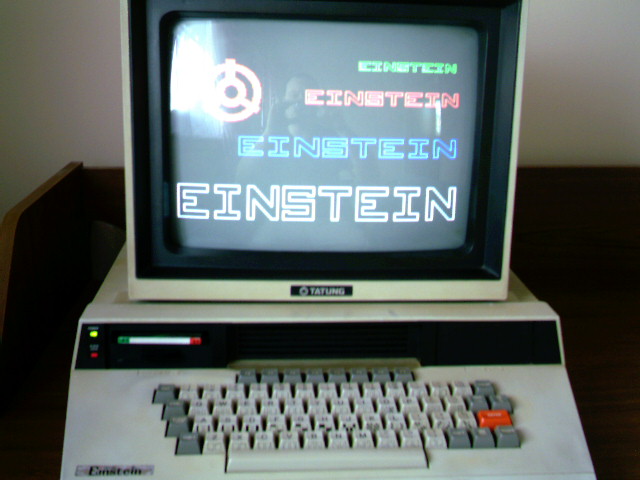
The Tatung Einstein was an eight bit home personal computer produced by Taiwanese corporation TATUNG but designed and assembled in England , at Telford. It was aimed primarily at small businesses.
The Einstein was released in the United Kingdom in the summer of 1984, and 5,000 were exported back to Taipei later that year. A Tatung monitor (monochrome or colour) and printer were also available as options.
The machine was physically large, with an option for one or two built-in three-inch floppy disk drives manufactured by Hitachi. At the time, most home computers used ordinary tape recorders for storage. Another unusual feature of the Einstein was that on start-up the computer entered a simple machine code monitor, called MOS (Machine Operating System). A variety of software could then be loaded from disk, including a CP/M -compatible operating system named Xtal, and a BASIC interpreter.
More expensive than most of its rivals (priced at £499 for the computer alone without monitor), and lacking an obvious niche market other than technically-advanced home programmers, the Einstein was commercially unsuccessful.
Technical specifications
CPU : Zilog Z80-A @ 4 Mhz
RAM: 64 Kb system RAM; 8 Kb ROM with expansion for up to 32k internally; 16 Kb seperate video RAM
Display : Hi-Res graphics 256 x 192 pixels, plus 32 planes of "sprites". In addition to "sprites" there is a text/graphics and backdrop plane. The display is capable of 16 colours.
Display Format : Raster Scanned 625 lines 50Hz field non-interlaced; Resolution 256 x 192 pixels.
Display Priority : Sprite 0 (Highest), Sprite 31, Text/Graphics, and Backdrop (lowest)
Character Generator : 96 alphanumeric characters and 160 graphics symbols. All characters and symbols are software re-progammable.
RF Output : UHF - 591.25 Mhz 1.5mv peak syncs, negative modulation, PAL encoded.
Display Output : YUV : Y-Luminance signal with negative going syncs. 1V p-p into 75 ohms. U & V-chrominance signals. 0.68V p-p into 75 ohms.
RGB and Syncs : 1V p-p into 75 ohms.
RS232-C Port : Full duplex capability to RS232-C/V24 standards. Transmission speeds are software programmable between 75 & 9600 bauds. Signals available - Tx data, Rx data, RTS, CTS, Ground.
User Port : 8 bit bi-directional with strobe and ready signals TTL levels.
Analogue to Digital Converter : 4 Channels, 8 bits resolution. Conversion speed less than 40us (for 8 bits). Input range 2V.
Printer Output : Centronics interface standard.
Tatung 'Pipe' : Z80A buffered bus to TTL Levels, with clock and control signals.
External Disc Interface : Provides signals for up to two self-powered external disc drives. Either 3 inch compact floppy, 3.5 inch micro floppy disc, or 5.25 inch mini floppy.
Programmable Sound Generator : A means of providing a variety of sounds, including chromatic music, with envelope shaping is provided. The sound generator has three 'voices'.
Sound Output : 250mW into internal 3.5 x 2.25 inch elliptical loudspeaker.
Switch Mode Power Supply Unit : Self Oscillating Flyback Converter 20 - 40Khz; Mains - 220V to 240V; 50 to 60Hz; Output (Fused @ 1AMP); External 5V output load.
Full QWERTY keyboard
Disc Drives : Teac FD30A 3 Inch disc drive is to be incorporated; Single Sided, 100 tpi, 40 tracks, MFM coding, Disc fully enclosed in a cassette - Access time 12ms track-track, 171ms average; 250K bit/sec transfer rate; 10 sectors per track; 512 bytes per sector.
